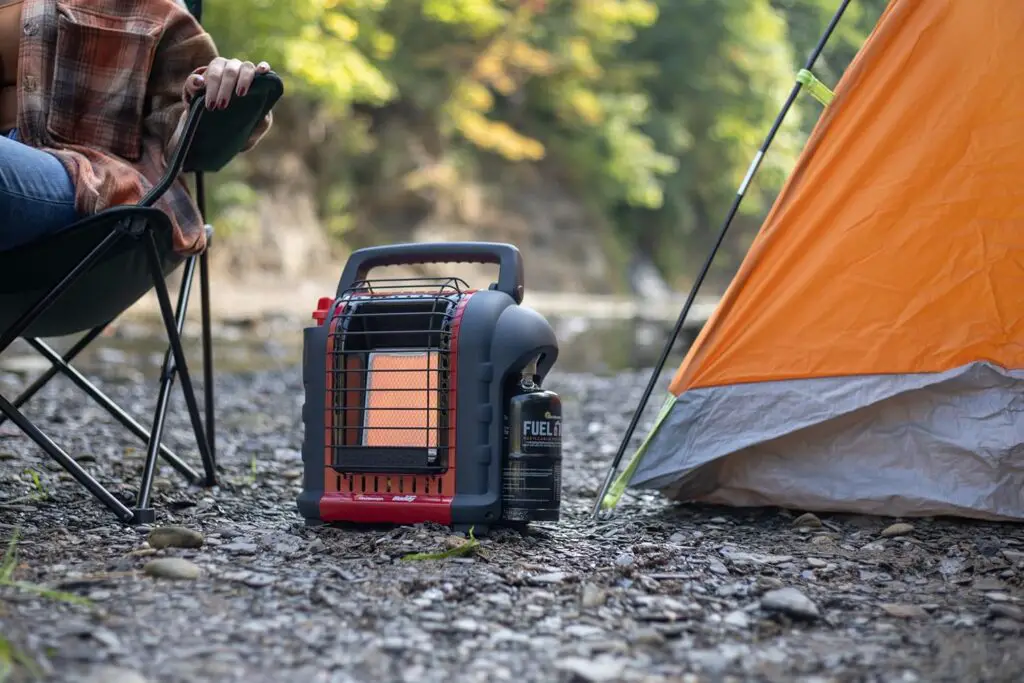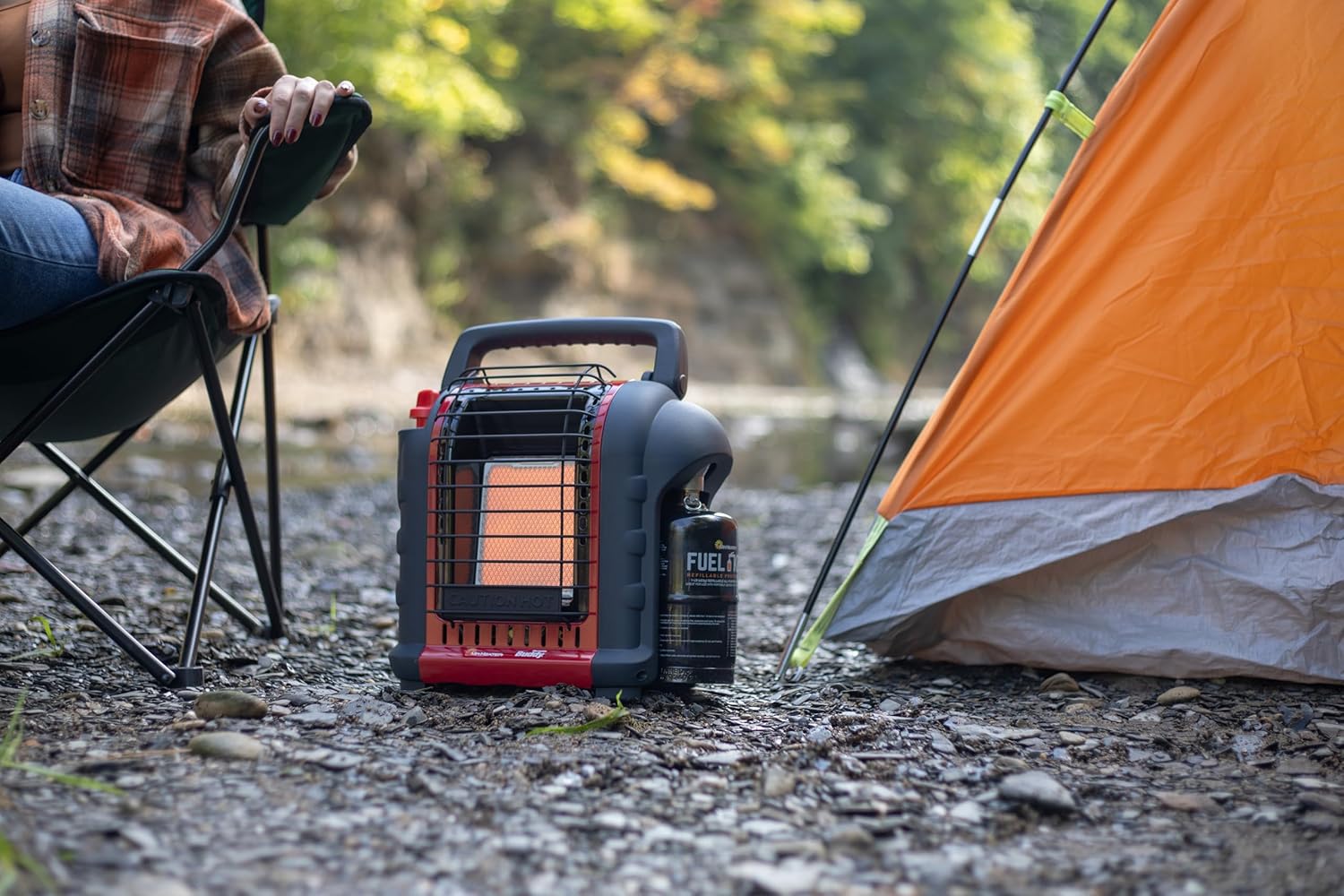This blog post may contain affiliate links. As an Amazon Associate I earn from qualifying purchases.
Are Tent Heaters Safe? A Camper’s Guide to Warm & Worry-Free Nights
Picture this – you’re snuggled in your sleeping bag on a chilly night, desperately wishing for some extra warmth. The temptation to grab any available heater and bring it into your tent is real – I’ve been there myself. But here’s something crucial every camper needs to know: the wrong choice of tent heater could turn a cozy camping trip into a dangerous situation. The U.S. Consumer Product Safety Commission specifically warns against using portable heaters while sleeping in enclosed spaces.
The good news? Modern tent heaters have come a long way in terms of safety features. Through countless cold-weather camping trips, I’ve learned to trust certain indoor-safe propane heaters equipped with reliable safety mechanisms like carbon monoxide detectors and automatic shut-offs. The secret lies in choosing the right heater and knowing exactly how to use it.
Let me share what I’ve discovered about tent heater safety over years of winter camping adventures. We’ll look at different types of heaters you can choose from, the safety features that really matter, and the proper setup techniques that keep you both warm and safe. Whether you’re thinking about an electric heater, considering propane, or exploring battery-powered options, I’ll help you make smart choices that put safety first while keeping you toasty on those cold camping nights.

Understanding Different Types of Tent Heaters
Let me tell you something about tent heaters – picking the right one can make the difference between a cozy night’s sleep and a miserable camping experience. After countless camping trips in all sorts of weather, I’ve gotten pretty familiar with three main types of heaters you’ll find on the market.
Electric Tent Heaters
Electric heaters are my go-to choice when it comes to tent safety. These trusty companions use either ceramic or infrared coils to create warmth, and many ceramic models come with a nifty little fan that spreads the heat around your tent space.
Here’s the catch though – electric heaters are power-hungry creatures. You’ll need one of these to keep them running:
- A campsite with electrical hookups (my preferred option)
- A decent portable power station
- A beefy battery bank that can handle the load
Propane Tent Heaters
Propane heaters pack quite a punch when it comes to heating power, and they’re super portable too. The newer indoor-safe models come loaded with some impressive safety features:
- Something called an Oxygen Depletion Sensor (ODS)
- Protection if the heater tips over
- Automatic shut-off systems that kick in when needed
But here’s the thing – you can’t just plop a propane heater in your tent and forget about it. These heaters actually use up oxygen as they burn, and while they usually produce very little carbon monoxide, a faulty unit could spell trouble.
Battery-Powered Heaters
Battery-powered heaters are the new kids on the block. Right now, you won’t find many heaters that can run on their own batteries for very long. Through trial and error, I’ve found this combo works best:
- A beefy power station (1000W or more)
- A smaller heater that sips power (200-400W)
For example, if you pair a 1000W power station with a 200W heater, you can keep warm for about 10 hours straight. It’s clean, quiet, and you don’t need to plug into anything.
My Top Picks for Tent Heaters:
Essential Safety Features in Modern Tent Heaters
You know what amazes me about today’s tent heaters? The incredible safety features packed into these compact devices. After testing dozens of models over the years, let me walk you through the safety mechanisms that help me sleep soundly in my tent.
Carbon Monoxide Detectors
The first thing I check on any tent heater is its carbon monoxide detection system. These smart little sensors keep watch while you rest, shutting down the heater if CO levels creep too high. Here’s a pro tip I learned the hard way – always bring a separate battery-powered CO detector made specifically for camping. Those regular house detectors just don’t cut it in a tent’s tight quarters.
Auto Shut-off Mechanisms
Modern heaters are like careful parents – always watching out for trouble. They come loaded with safety features that spring into action when needed:
- Knock the heater over? It shuts off instantly
- Oxygen getting low? Special sensors catch that right away
- Heat building up too much? Pressure sensors handle it
- Flame goes out? Emergency shutoff kicks in
Temperature Control Systems
The temperature control on these heaters reminds me of a well-trained chef – precise and reliable:
- HEYtronic technology keeps the temperature just right
- Double protection against overheating (because one backup isn’t enough!)
- Smart fan system that reduces startup problems
- Thermostats that maintain your perfect comfort zone
My Trusted Heater Picks:
Here’s something crucial I’ve learned from experience – even with all these fancy safety features, never leave your heater running while you sleep. Think of these features like a backup parachute – nice to have, but you don’t want to rely on them!
Top Recommended Safe Tent Heaters
Let me share something exciting – after countless nights testing different heaters in my tent, I’ve found some real gems. These aren’t just any heaters – they’re the ones I trust when the temperature drops and I need reliable warmth.
Best Electric Heater for Camping
The De’Longhi Ceramic Compact Heater has become my trusted companion whenever I camp at sites with power hookups. This little 1500-watt champion really knows its stuff:
| Feature | Description |
|---|---|
| Heat Output | Multiple settings for precise temperature control |
| Noise Level | Proprietary silent system technology |
| Coverage | Oscillating function for even heat distribution |
| Controls | LED interface with remote control capability |
Safest Propane Heater Option
When it comes to propane heaters, nothing beats the Mr. Heater Big Buddy for larger tents. I’ve used this dual-canister system in some pretty cold conditions, and here’s what makes it special:
| Specification | Detail |
|---|---|
| Maximum Output | 18,000 BTUs |
| Runtime | 10.8 hours on lowest setting |
| Safety Features | Tip-over protection and oxygen depletion sensor |
| Fuel Type | Dual 1lb propane canisters |
Most Reliable Battery-Powered Choice
For those times when I’m really going off-grid, the Honeywell HeatBud Ceramic Space Heater has never let me down. Here’s what you get:
| Attribute | Value |
|---|---|
| Power Draw | 170-250 watts |
| Heat Output | 850 BTUs |
| Safety | Overheat and tip-over protection |
| Compatibility | Works with portable power stations |
Setting Up Your Tent Heater Safely
Setting up a tent heater might seem straightforward, but trust me – there’s more to it than just plugging in and turning on. After countless cold nights figuring out the perfect setup, let me share my tried-and-true system for staying both warm and safe.
Proper Ventilation Guidelines
The first rule of tent heater club? Always keep the air flowing! Here’s what works for me:
- Crack open at least one tent vent or window
- Keep that tent door partially unzipped
- Check your ventilation spots regularly
You might think canvas tents with their natural breathability don’t need extra ventilation, but they absolutely do. This is especially true with propane heaters – proper airflow is your best defense against carbon monoxide buildup.
Safe Distance Requirements
Playing the distance game with tent heaters is crucial. Here’s my safety zone chart:
| Direction | Required Distance |
|---|---|
| Sides/Back | 18 inches minimum |
| Top/Front | 4 feet clearance |
| From LPG Tank | 6 feet minimum |
My favorite spot for the heater? The corner diagonally opposite from where I sleep. It’s like finding the sweet spot between safety and staying toasty.
Power Source Considerations
Different heaters need different setups. Here’s what I’ve learned works best:
Electric Heaters:
- Only use those GFCI-protected outlets
- Match your power source to your heater’s needs
- Keep those connections dry as a bone
Propane Systems:
- Give those fittings a good check before lighting up
- Stick to LPG-resistant pipe compounds
- Keep fuel containers outside where they belong
Battery-Powered Units:
- Baby those batteries in cold weather
- Wrap power banks in insulation
- Keep an eye on those battery levels
My Must-Do Safety Checklist:
- Get that carbon monoxide detector up
- Find solid, level ground for your heater
- Clear away anything that could catch fire
- Keep your eyes on that heater
One last thing I’ve learned the hard way – even the fanciest heater needs watching. That’s why mine always gets switched off before I drift off to sleep.
You know what I love most about camping? Those peaceful moments when you’re all cozy in your tent, protected from the cold outside. Getting there safely with a tent heater isn’t rocket science, but it does need some common sense and careful planning.
Through my camping adventures, I’ve learned that tent heaters can be fantastic companions when used right. The key isn’t just picking the fanciest heater with the most features – it’s about understanding your needs and following safety guidelines like they’re camp rules.
Remember those chilly nights when I first started using tent heaters? They taught me that comfort should never come at the cost of safety. Whether you go for electric, propane, or battery-powered options, always keep your carbon monoxide detector handy and maintain proper ventilation.
Final Thoughts – Safe Tent Heater Usage
Nothing beats the feeling of staying warm and cozy in your tent while the temperature drops outside. Tent heaters can be fantastic companions for cold-weather camping, but here’s something every camper needs to remember – safety always comes first. Electric heaters have proven themselves as the most reliable choice in my experience, though propane and battery-powered options work great too when you follow the right precautions.
The secret to happy tent heating boils down to three simple things: picking a heater with solid safety features, keeping your tent properly ventilated, and actually reading those manufacturer guidelines (yes, really!). Plus, that separate carbon monoxide detector isn’t just an extra precaution – it’s your backup guardian while you rest.
After spending countless nights in tents across all sorts of weather, I can tell you this – no amount of warmth is worth taking chances with safety. Switch off those heaters before drifting off to sleep, keep them well away from tent walls and gear, and you’ll be set for a comfortable night outdoors. Smart campers know that a little preparation and attention to safety makes all the difference between a great camping story and one you’d rather forget.


